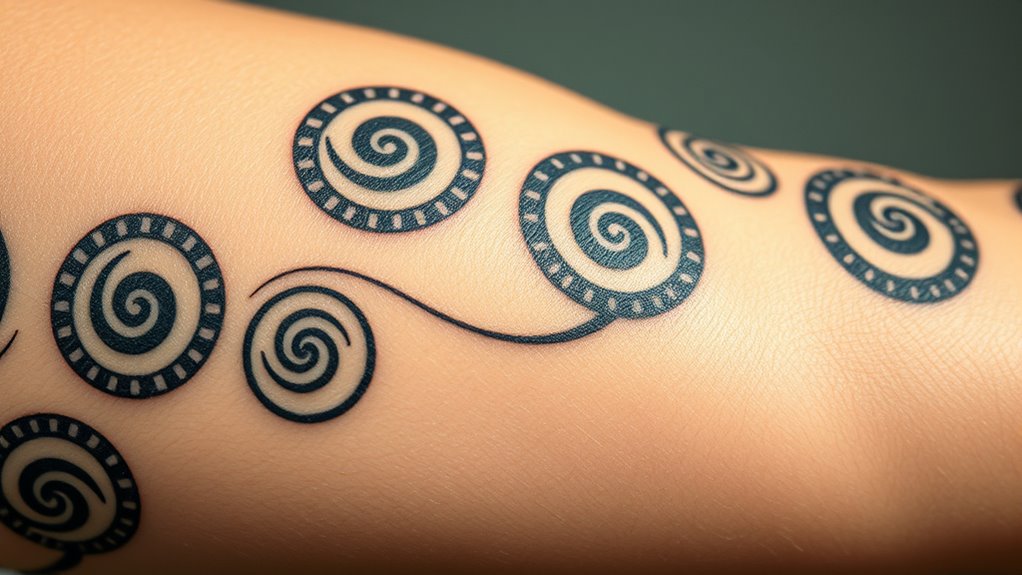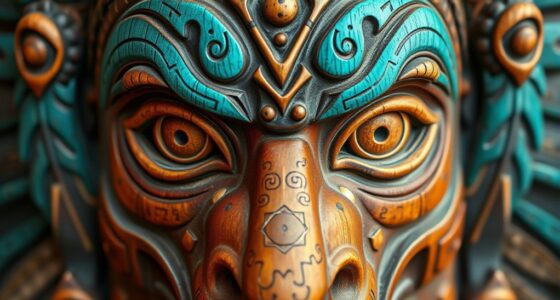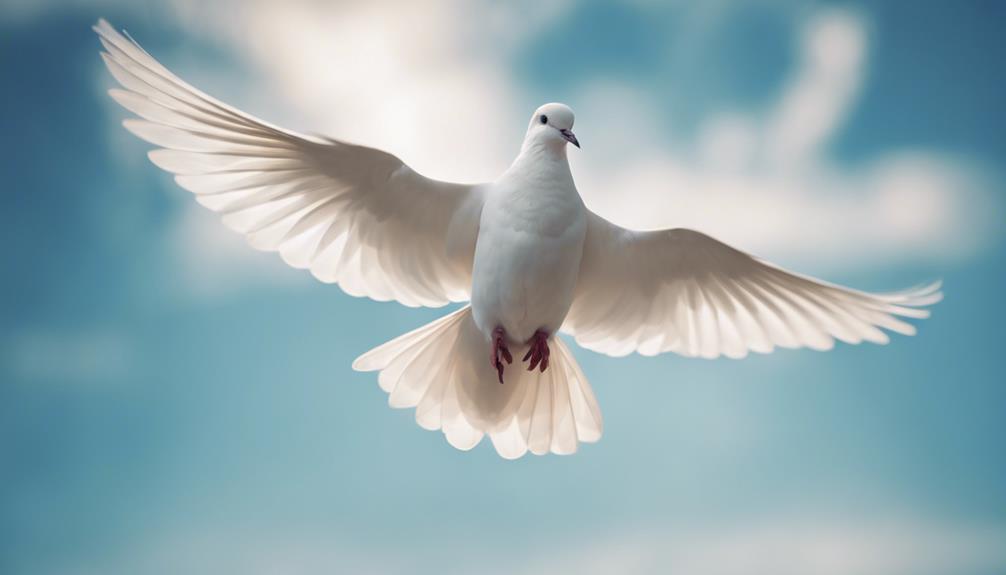Spiral patterns connect ancient art to modern tattoos by showcasing nature’s mathematical beauty and cultural symbolism. You’ll see them in everything from Celtic symbols and Greek motifs to contemporary body art, representing growth, eternity, and life’s cycles. These dynamic shapes evoke movement and harmony, bridging science and art. Exploring their origins reveals how they’ve timelessly inspired design, spirituality, and personal expression—keep going to uncover how these symbols continue to resonate today.
Key Takeaways
- Spiral patterns are rooted in mathematical principles like Fibonacci sequences and the golden ratio, creating aesthetically pleasing designs.
- They have been used in ancient art and symbolism to represent growth, eternity, and spiritual journeys across cultures.
- Spirals naturally occur in biological structures (e.g., shells, galaxy arms), emphasizing their connection to nature and science.
- Modern tattoos and design incorporate spiral motifs to evoke movement, harmony, and cultural symbolism.
- The enduring appeal of spiral patterns bridges ancient symbolism with contemporary art, emphasizing their universal significance.

Have you ever wondered why spiral patterns appear so frequently in nature and art? These mesmerizing shapes aren’t just visually appealing—they’re rooted in fascinating mathematical properties that make them inherently efficient and dynamic. Spirals often follow specific mathematical principles, such as the Fibonacci sequence or the golden ratio, which create proportions that are both balanced and aesthetically pleasing. This mathematical consistency allows spirals to grow naturally and efficiently, whether in the arrangement of sunflower seeds or the swirling arms of galaxies. When you look at a nautilus shell or a hurricane, you’re witnessing nature’s mastery of these mathematical properties, which enable complex structures to develop smoothly over time. This intrinsic link between spirals and mathematics explains why they’re so prevalent across different scales and contexts.
Beyond their scientific foundation, spiral patterns carry deep cultural symbolism that resonates across civilizations. Ancient cultures, from the Celts to the Greeks, used spirals as symbols of growth, eternity, and spiritual evolution. You might see this in Celtic art, where spirals represent the cycles of life and the interconnectedness of the universe. In many indigenous traditions, spirals symbolize spiritual journeys or the passage of time, illustrating how humans have long associated these shapes with profound meaning. Today, this symbolism persists, influencing modern art, tattoos, and design. When you choose a spiral tattoo, it might represent personal growth, transformation, or continuity—ideas that have been conveyed through these patterns for thousands of years. The cultural symbolism behind spirals elevates them from mere decorative elements to powerful visual metaphors for life’s ongoing cycles.
In contemporary contexts, spiral patterns continue to enchant because they evoke a sense of movement and harmony. Artists and designers incorporate these shapes to create dynamic compositions that draw the eye inward or outward, guiding viewers through a visual journey. When you see a spiral staircase or a swirling mural, it’s no coincidence—these designs harness the natural allure of spirals rooted in their mathematical and symbolic significance. Whether in ancient carvings or modern tattoos, the enduring appeal of spirals lies in their ability to bridge science and culture seamlessly. They remind us of nature’s efficiency and humanity’s collective understanding of life’s perpetual cycles. So, next time you encounter a spiral pattern, recognize it as a timeless symbol—born from mathematical properties, rich with cultural symbolism, and forever embedded in our visual and spiritual landscape.
Frequently Asked Questions
What Cultural Significance Do Spiral Patterns Hold Globally?
You’ll find spiral patterns hold deep cultural symbolism worldwide, representing concepts like growth, evolution, and life’s journey. These universal motifs appear in ancient art, religious symbols, and modern tattoos, emphasizing their timeless significance. Globally, spirals connect communities, embody spiritual beliefs, and illustrate natural cycles. By recognizing their widespread use, you see how these patterns serve as powerful symbols of unity and transformation across diverse cultures.
How Do Artists Create Perfect Spiral Designs in Tattoo Art?
You can create perfect spiral designs in tattoo art by mastering techniques overview like using a steady hand and precise tools. For example, a tattoo artist might employ a compass or stencil to guarantee symmetry. Be aware of common mistakes such as uneven spacing or inconsistent line weight, which can distort the spiral’s flow. Practice and attention to detail help you achieve smooth, balanced spirals that stand out.
Are There Specific Materials Preferred for Ancient Spiral Carvings?
You should know that preferred carving materials for ancient spiral carvings often included soft stones like soapstone, limestone, and sandstone, making them easier to carve with primitive tools. Ancient carving techniques relied on manual tools such as chisels and burins, allowing artisans to create precise spiral patterns. These materials and techniques helped guarantee durability and clarity, preserving the intricate designs over centuries.
How Have Modern Technologies Influenced Spiral Pattern Tattooing?
Ironically, modern tech makes spiral tattoos more precise than ancient carvings. You use digital ink and 3D modeling to design intricate, flawless patterns, pushing artistic limits. These tools allow you to customize size, shape, and flow effortlessly, giving you control once unimaginable. As a result, your spiral tattoos can be more complex and symmetrical, blending ancient symbolism with cutting-edge innovation—proof that technology truly transforms art, even in skin-deep forms.
What Are the Symbolic Meanings Behind Different Spiral Styles?
You see, different spiral styles carry deep symbolic meanings. Cosmic symbolism often links spirals to the universe, representing eternity and life’s cycles. Some designs illustrate spiritual journeys, symbolizing growth, transformation, or inner exploration. Whether you’re drawn to tight, controlled spirals or expansive, free-flowing ones, each style reflects personal or universal concepts, helping you connect with deeper meanings, spiritual paths, or the cosmos through your tattoo.
Conclusion
Spiral patterns have intertwined human history and modern expression, from ancient carvings to contemporary tattoos. They symbolize growth, eternity, and life’s cycles. Did you know that over 70% of tattoo enthusiasts choose spiral designs for their symbolic meaning? By understanding their rich history, you can appreciate how these patterns connect us to our ancestors and ourselves. Embrace the timeless beauty of spirals—it’s a personal journey that links the past with your present.











